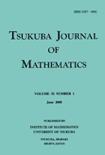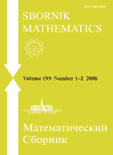
JOURNAL D ANALYSE MATHEMATIQUE
Scope & Guideline
Exploring the Depths of Mathematical Theory.
Introduction
Aims and Scopes
- Mathematical Analysis and Differential Equations:
The journal publishes significant contributions to the study of differential equations, particularly focusing on elliptic and parabolic equations, as well as their applications to physical and geometric problems. - Functional Analysis and Operator Theory:
Research related to functional spaces, operator algebras, and spectral theory is a core area, exploring the properties and applications of various operators in mathematical analysis. - Harmonic Analysis and Fourier Analysis:
Publications often delve into harmonic analysis, including Fourier multipliers and restriction theorems, with a focus on both classical and contemporary developments. - Geometric Analysis and Topology:
The journal includes studies on geometric and topological aspects of analysis, examining the interplay between geometry and analysis through various mathematical constructs. - Ergodic Theory and Dynamical Systems:
There is a consistent emphasis on ergodic theory, exploring the dynamics of systems and their statistical properties, which is often tied to number theory and combinatorial structures.
Trending and Emerging
- Semiclassical Analysis and Quantum Mechanics:
Recent publications indicate a growing interest in semiclassical analysis, particularly in relation to quantum mechanics, suggesting a trend towards integrating physical concepts with mathematical rigor. - Stochastic Processes and Random Analysis:
There is an emerging focus on stochastic processes, highlighting the increasing relevance of randomness and probabilistic methods in mathematical analysis. - Higher-Dimensional and Nonlocal Problems:
Research addressing higher-dimensional analysis and nonlocal problems is gaining traction, reflecting a shift towards exploring complex interactions and phenomena in various mathematical contexts. - Applications of Functional Analysis in Complex Systems:
There is a notable trend towards applying functional analysis techniques to complex systems, including dynamical systems and statistical mechanics, showcasing the interdisciplinary nature of current research.
Declining or Waning
- Classical Number Theory:
Research articles focusing exclusively on classical number theory aspects have decreased, possibly due to a broader trend towards more applied or computational approaches in modern mathematics. - Elementary Geometry:
Papers that concentrate on elementary geometric methods have waned, indicating a possible shift towards more complex or abstract geometric analysis. - Nonlinear Partial Differential Equations without Geometric Context:
There is a noticeable reduction in studies addressing nonlinear PDEs in isolation from geometric or physical contexts, suggesting a preference for interdisciplinary approaches.
Similar Journals

ANNALES DE L INSTITUT FOURIER
Championing Rigorous Research and CollaborationANNALES DE L INSTITUT FOURIER is a premier academic journal published by ANNALES INST FOURIER, specializing in the fields of Algebra and Number Theory as well as Geometry and Topology. Since its establishment, the journal has garnered a distinguished reputation, evidenced by its Q1 quartile ranking in the 2023 category assessments and its Scopus Rank of #37 out of 119 in Algebra and Number Theory, and #34 out of 106 in Geometry and Topology, placing it within the top percentile of its field. The journal serves as a vital platform for disseminating groundbreaking research and innovative methodologies, catering to a global audience of researchers, professionals, and students. With a commitment to the advancement of mathematical sciences, ANNALES DE L INSTITUT FOURIER invites contributions that push the boundaries of knowledge and foster collaboration across disciplines. Although it does not offer open access, the rigorous peer-review process ensures that published papers meet the highest academic standards, making it a critical resource for anyone engaged in advanced mathematical research.

Tsukuba Journal of Mathematics
Fostering Innovation in Mathematics through Scholarly ExchangeTsukuba Journal of Mathematics is a distinguished publication dedicated to advancing the field of mathematics through the dissemination of innovative research and comprehensive studies. Published by the University of Tsukuba, Department of Mathematics, this journal serves as a vital platform for mathematicians, researchers, and students to engage with cutting-edge mathematical theories and methodologies. Although currently not available as an open-access journal, it maintains a strong academic presence, contributing significantly to the global mathematical landscape. The journal invites submissions across various branches of mathematics, aiming to foster scholarly communication and collaboration. The ISSN 0387-4982 and the E-ISSN 2423-821X further establish its credibility and accessibility among the academic community, supporting its critical objective of facilitating high-quality research output. Situated in Tsukuba, Japan, a hub for scientific research and development, the Tsukuba Journal of Mathematics is committed to bridging gaps in mathematical knowledge and encouraging exploration of novel ideas.

European Journal of Mathematics
Fostering Innovation in MathematicsWelcome to the European Journal of Mathematics, a prominent publication that serves as a vital platform for disseminating high-quality research in the field of mathematics. Published by Springer International Publishing AG, this journal has witnessed significant growth since its inception in 2015 and is recognized for its contributions within the Q2 category of Mathematics (miscellaneous) as per the 2023 rankings. With an ISSN of 2199-675X and an E-ISSN of 2199-6768, the journal aims to foster innovation and collaboration among researchers, professionals, and students alike. Although it operates under a traditional access model, the journal's commitment to advancing mathematical knowledge and applications cannot be overstated. Positioned among the top-tier publications, the European Journal of Mathematics is an essential resource that encourages the exploration of emerging trends and theories in mathematics, making it indispensable for anyone striving to stay at the forefront of this dynamic field.

Mediterranean Journal of Mathematics
Connecting Scholars Through High-Quality Mathematical ResearchThe Mediterranean Journal of Mathematics, published by SPRINGER BASEL AG, is a prominent platform dedicated to the advancement of mathematical research and education. Since its inception in 2004, this journal has been pivotal in disseminating high-quality research across various fields of mathematics, currently holding a notable Q2 ranking in the miscellaneous mathematics category as of 2023. With its ISSN 1660-5446 and E-ISSN 1660-5454, the journal enjoys a respected position in the academic community, evident by its Scopus rank of 129 out of 399 in General Mathematics, placing it in the 67th percentile. While primarily a subscription-based journal, it remains committed to providing a comprehensive resource for researchers, professionals, and students, fostering dialogue and exploration within the mathematical sciences. The Mediterranean Journal of Mathematics, based in Basel, Switzerland, continues to contribute significantly to the evolution of mathematical theory and practice, marking its relevance as we approach its 20th anniversary in 2024.

Revista Matematica Complutense
Advancing Mathematical Frontiers with Rigorous ResearchRevista Matematica Complutense is a prestigious peer-reviewed journal published by SPRINGER-VERLAG ITALIA SRL, specializing in the field of mathematics. With its ISSN 1139-1138 and E-ISSN 1988-2807, the journal plays a vital role in disseminating high-quality research and fostering academic discussion within the mathematics community. Recognized for its rigorous selection process, the journal has achieved impressive rankings, holding a Q1 quartile status in the miscellaneous mathematics category as of 2023 and ranking #94 out of 399 in general mathematics according to Scopus, placing it within the 76th percentile. With a publication timeline spanning from 2008 to 2024, the Revista Matematica Complutense continues to serve as an essential resource for researchers, professionals, and students alike. Although it does not currently offer open access, the journal remains committed to advancing mathematical knowledge and providing a platform for innovative research across various mathematical disciplines.

PUBLICATIONES MATHEMATICAE DEBRECEN
Advancing Mathematical Frontiers with Rigorous ResearchPublicationes Mathematicae Debrecen is a renowned international journal published by the University of Debrecen, Institute of Mathematics, situated in Hungary. This journal, with both ISSN 0033-3883 and E-ISSN 2064-2849, has established itself in the field of mathematics since its inception, with coverage extending from 1997 to 2024. Recognized for its rigorous academic standards, it currently holds a Q3 ranking in the mathematics (miscellaneous) category for 2023 and ranks at the 42nd percentile among general mathematics journals in Scopus. Publicationes Mathematicae Debrecen aims to disseminate high-quality research across various areas of mathematics, contributing to the advancement of knowledge and practice in this dynamic field. Although it is not an open-access journal, its readers can access a wealth of scholarly work that addresses both theoretical and applied mathematical issues, making it an invaluable resource for researchers, professionals, and students alike.

COLLOQUIUM MATHEMATICUM
Exploring the depths of mathematics for a global audience.COLLOQUIUM MATHEMATICUM, published by ARS POLONA-RUCH, serves as an essential platform for the dissemination of innovative research in the field of mathematics. With an ISSN of 0010-1354 and a dedicated E-ISSN of 1730-6302, this journal plays a crucial role in advancing mathematical knowledge and fostering collaboration within the academic community. Although it is categorized in the Q3 quartile for miscellaneous mathematics, its content consistently attracts a diverse readership, reflecting a wide array of mathematical disciplines. Spanning publication years from 2001 to 2009 and resuming from 2011 to the present, *COLLOQUIUM MATHEMATICUM* offers researchers, professionals, and students the unique opportunity to engage with groundbreaking concepts and methodologies. With its home base in Warsaw, Poland, this journal not only contributes to the regional mathematical landscape but also impacts the broader global community. While currently not adopting an open access model, the journal remains committed to quality research, evidenced by its Scopus ranking within the general mathematics category. Engage with *COLLOQUIUM MATHEMATICUM* to be at the forefront of mathematical exploration.

Journal of Contemporary Mathematical Analysis-Armenian Academy of Sciences
Elevating Mathematical Discourse for Real-World ImpactThe Journal of Contemporary Mathematical Analysis, published by PLEIADES PUBLISHING INC, is a prominent peer-reviewed journal dedicated to advancing the field of mathematics. With ISSN 1068-3623 and E-ISSN 1934-9416, this journal serves as a platform for scholars to disseminate innovative research in various subfields, including analysis, applied mathematics, control, and optimization. Established in 2009 and running until 2024, the journal is recognized in the Q4 category across its domains, reflecting its evolving impact within the academic community. Despite currently ranking in the lower quartiles according to Scopus metrics, it is an invaluable resource for emerging researchers and professionals seeking to contribute to and engage with contemporary mathematical theories and applications. The journal’s focus on bridging theory with practical application makes it essential for those working at the intersection of mathematics and its diverse real-world applications.

SBORNIK MATHEMATICS
Exploring Innovative Insights in MathematicsSBORNIK MATHEMATICS is a distinguished journal dedicated to advancing research in the field of mathematics, particularly focusing on areas such as algebra and number theory. Published by the esteemed Steklov Mathematical Institute of the Russian Academy of Sciences, this journal has been a prominent platform for scholarly communication since its inception in 1993 and continues to thrive with contributions of significant relevance through 2024. The journal maintains a Q2 ranking in both the algebra and number theory category as well as in miscellaneous mathematics, highlighting its competitive standing in the mathematical community. While it is not an open-access publication, it offers critical insights and innovative research that are vital for mathematicians, researchers, and students alike. With an ISSN of 1064-5616 and an E-ISSN of 1468-4802, SBORNIK MATHEMATICS serves as a crucial resource for anyone looking to deepen their understanding of contemporary mathematical developments.

Moscow University Mathematics Bulletin
Advancing Mathematical Discourse and DiscoveryMoscow University Mathematics Bulletin is a distinguished academic journal published by Springer International Publishing AG, focusing on the dynamic field of mathematics. With an ISSN of 0027-1322 and an E-ISSN of 1934-8444, this journal serves as a platform for innovative research and developments in various mathematics sub-disciplines, making significant contributions to both theoretical and applied mathematics. While it holds a Q3 ranking in the field of Mathematics (miscellaneous) for 2023, this journal remains dedicated to fostering academic discourse among mathematicians. Researchers, professionals, and students will find value in the diverse range of articles that embody rigor and creativity. Although currently not an Open Access publication, the journal provides numerous access options through institutional or personal subscriptions. From its inception in 2007 to its expected continuity until 2024, the Moscow University Mathematics Bulletin is committed to enhancing the understanding and appreciation of mathematical sciences.